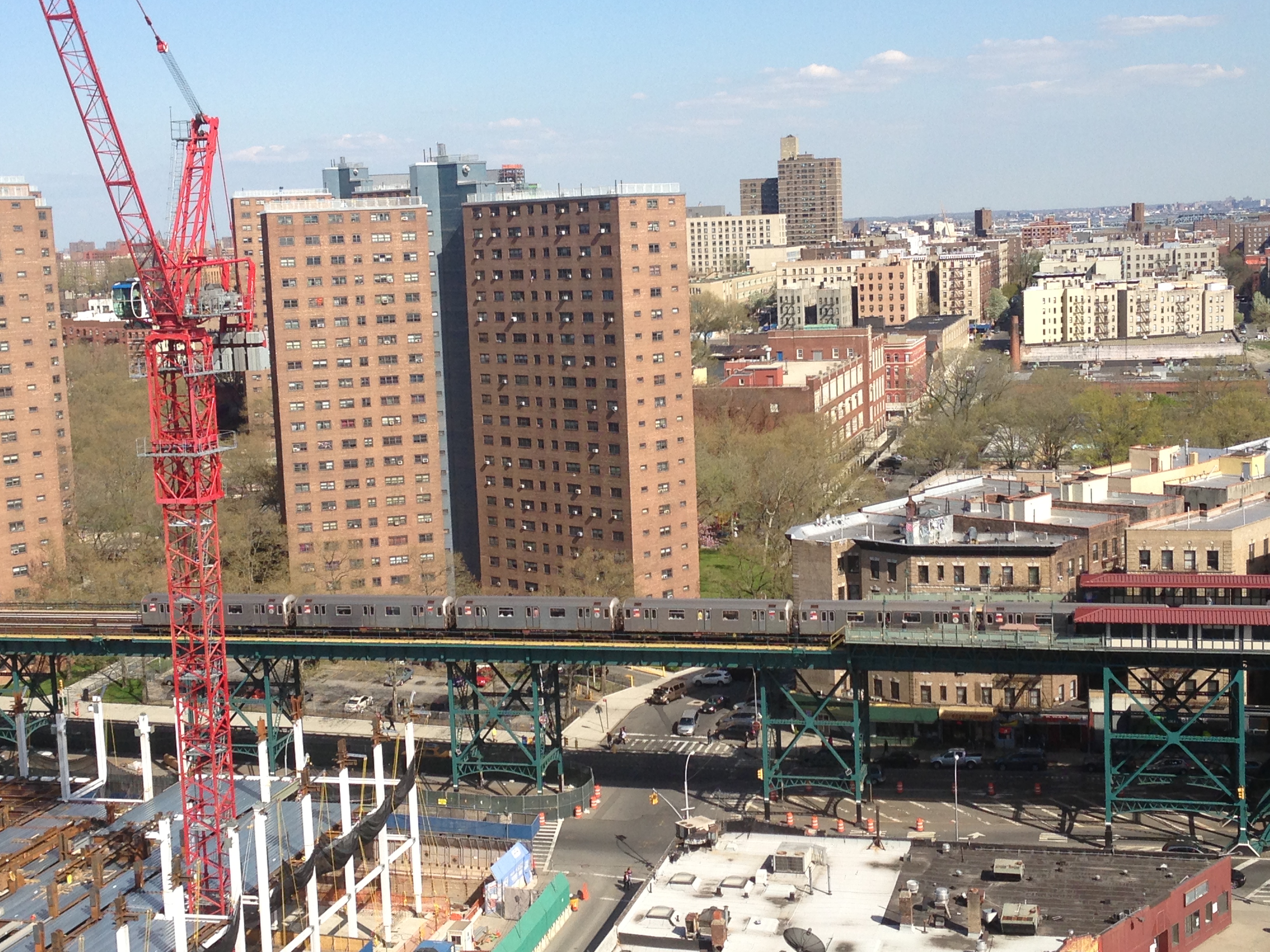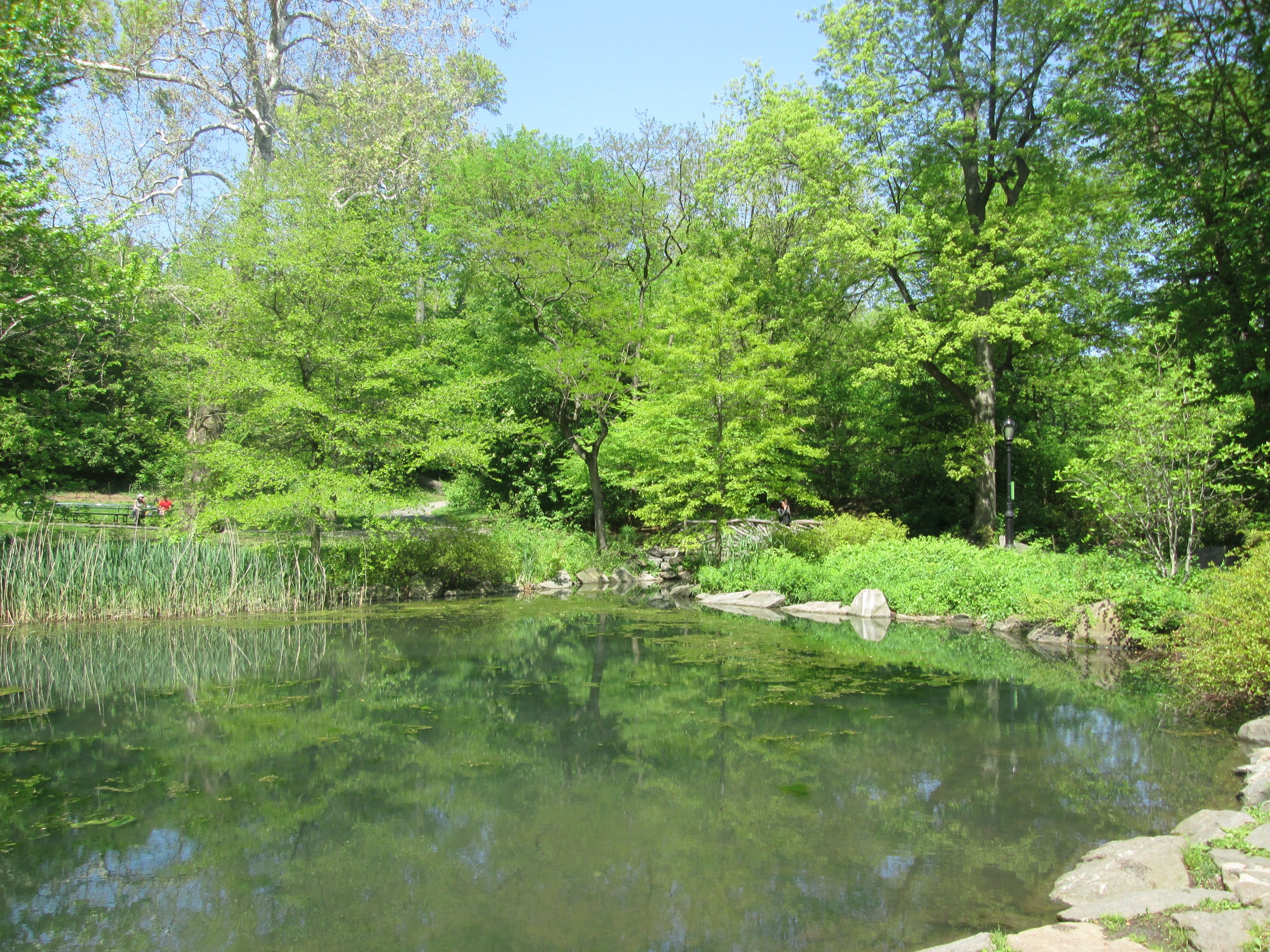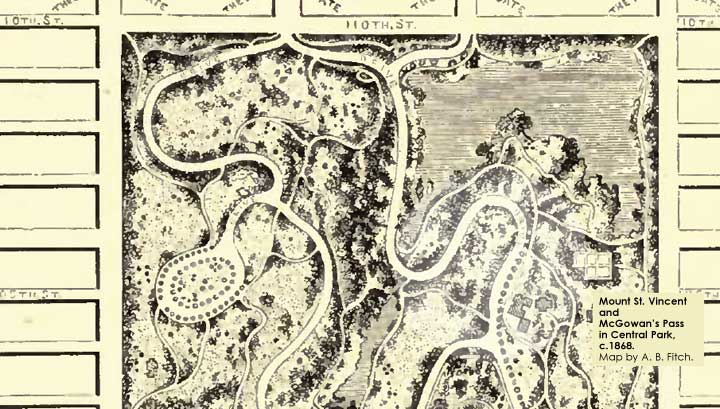|
Nutter's Battery
Nutter's Battery is a scenic overlook in the North Woods of Central Park in Manhattan, New York City, overlooking the Harlem Meer to the north. The battery was built during the War of 1812 as a small part of an extensive system of fortification intended to defend against a British invasion from the north. After the war, the wall fell into ruin and eventually disappeared. The Parks Department built a low wall in 1945 to mark the spot, and the Central Park Conservancy rebuilt the wall in 2014, adding paths and planting. The battery was named after Valentine Nutter, who owned the surrounding property. According to maps and illustrations of the time, the Battery was a redoubt connected to Fort Fish, by earthworks along the Old Post Road. At the line of 107th Street and Sixth Avenue (Lenox Avenue), the earthworks led to a gatehouse in the road at McGowan's Pass. From there the earthworks continued up a rocky hill to Fort Clinton. [...More Info...] [...Related Items...] OR: [Wikipedia] [Google] [Baidu] |
Manhattanville Forts
Manhattanville (also known as West Harlem or West Central Harlem, after its location near Harlem) is a neighborhood in the New York City borough of Manhattan. It is bordered on the north by 135th Street; on the south by 122nd and 125th Streets; on the west by Hudson River; and on the east by Adam Clayton Powell Jr. Boulevard and the campus of City College. Throughout the nineteenth century, Manhattanville bustled around a wharf active with ferry and daily river conveyances. It was the first station on the Hudson River Railroad running north from the city, and the hub of daily stage coach, omnibus and streetcar lines. Situated near Bloomingdale Road, its hotels, houses of entertainment and post office made it an alluring destination of suburban retreat from the city, yet its direct proximity to the Hudson River also made it an invaluable industrial entry point for construction materials and other freight bound for Upper Manhattan. With the construction of road and railway v ... [...More Info...] [...Related Items...] OR: [Wikipedia] [Google] [Baidu] |
North Woods (Central Park)
North Woods and North Meadow are two interconnected features in the northern section of Central Park, New York City, close to the neighborhoods of the Upper West Side and Harlem in Manhattan. The North Woods, in the northwestern corner of the park, is a rugged woodland that contains a forest called the Ravine, as well as two water features called the Loch and the Pool. The western portion of the North Woods also includes Great Hill, the third highest point in Central Park. North Meadow, a recreation center and sports complex, is immediately southeast of the North Woods. Completed in the 1860s, North Woods and North Meadow were among the last parts of Central Park to be built. History Construction North Woods and North Meadow, located between 97th and 110th Streets in Central Park, were among the last parts of the park to be built. While construction on the southern part of the park started in 1857, the northernmost four blocks between 106th and 110th Streets were not ev ... [...More Info...] [...Related Items...] OR: [Wikipedia] [Google] [Baidu] |
Central Park
Central Park is an urban park between the Upper West Side and Upper East Side neighborhoods of Manhattan in New York City, and the first landscaped park in the United States. It is the List of parks in New York City, sixth-largest park in the city, containing , and the most visited urban park in the United States, with an estimated 42 million visitors annually . It is also one of the most filmed locations in the world. The creation of a large park in Manhattan was first proposed in the 1840s, and a park approved in 1853. In 1858, landscape architects Frederick Law Olmsted and Calvert Vaux won a Architectural design competition, design competition for the park with their "Greensward Plan". Construction began in 1857; existing structures, including a majority-Black settlement named Seneca Village, were seized through eminent domain and razed. The park's first areas were opened to the public in late 1858. Additional land at the northern end of Central Park was purchased in ... [...More Info...] [...Related Items...] OR: [Wikipedia] [Google] [Baidu] |
Manhattan
Manhattan ( ) is the most densely populated and geographically smallest of the Boroughs of New York City, five boroughs of New York City. Coextensive with New York County, Manhattan is the County statistics of the United States#Smallest, largest, and average area per state and territory, smallest county by area in the U.S. state of New York (state), New York. Located almost entirely on Manhattan Island near the southern tip of the state, Manhattan constitutes the center of the Northeast megalopolis and the urban core of the New York metropolitan area. Manhattan serves as New York City's Economy of New York City, economic and Government of New York City, administrative center and has been described as the cultural, financial, Media in New York City, media, and show business, entertainment capital of the world. Present-day Manhattan was originally part of Lenape territory. European settlement began with the establishment of a trading post by Dutch colonization of the Americas, D ... [...More Info...] [...Related Items...] OR: [Wikipedia] [Google] [Baidu] |
New York City
New York, often called New York City (NYC), is the most populous city in the United States, located at the southern tip of New York State on one of the world's largest natural harbors. The city comprises five boroughs, each coextensive with a respective county. The city is the geographical and demographic center of both the Northeast megalopolis and the New York metropolitan area, the largest metropolitan area in the United States by both population and urban area. New York is a global center of finance and commerce, culture, technology, entertainment and media, academics, and scientific output, the arts and fashion, and, as home to the headquarters of the United Nations, international diplomacy. With an estimated population in 2024 of 8,478,072 distributed over , the city is the most densely populated major city in the United States. New York City has more than double the population of Los Angeles, the nation's second-most populous city. [...More Info...] [...Related Items...] OR: [Wikipedia] [Google] [Baidu] |
Harlem Meer
Harlem Meer is a man-made lake at the northeast corner of New York City's Central Park. It lies west of Fifth Avenue, south of 110th Street, and north of the Conservatory Garden, near the Harlem and East Harlem neighborhoods of Manhattan. The lake, as originally constructed, was , but after the completion in 1966 of the Lasker skating rink and swimming pool, it was reduced to approximately in area and approximately in circumference. History Before the creation of Central Park Harlem Meer was constructed at the confluence of three streams: first, Harlem Creek flowing from the north, just west of Fifth Avenue; second, an unnamed stream flowing from the west along what would become 110th Street; and third, Montayne's Rivulet, a stream flowing down a ravine from the southwest (the only one of the three still in existence). At this confluence with its two tributaries, Harlem Creek became Harlem Marsh, a semi-brackish, partly tidal wetland, flowing in an easterly direction (betwe ... [...More Info...] [...Related Items...] OR: [Wikipedia] [Google] [Baidu] |
War Of 1812
The War of 1812 was fought by the United States and its allies against the United Kingdom of Great Britain and Ireland, United Kingdom and its allies in North America. It began when the United States United States declaration of war on the United Kingdom, declared war on Britain on 18 June 1812. Although peace terms were agreed upon in the December 1814 Treaty of Ghent, the war did not officially end until the peace treaty was ratified by the 13th United States Congress, United States Congress on 17 February 1815. AngloAmerican tensions stemmed from long-standing differences over territorial expansion in North America and British support for Tecumseh's confederacy, which resisted U.S. colonial settlement in the Old Northwest. In 1807, these tensions escalated after the Royal Navy began enforcing Orders in Council (1807), tighter restrictions on American trade with First French Empire, France and Impressment, impressed sailors who were originally British subjects, even those who ... [...More Info...] [...Related Items...] OR: [Wikipedia] [Google] [Baidu] |
Central Park Conservancy
The Central Park Conservancy is an American private, nonprofit park conservancy that manages New York City's Central Park under a contract with the government of New York City and NYC Parks. The conservancy employs most maintenance and operations staff in the park. It effectively oversees the work of both the private and public employees under the authority of the publicly appointed Central Park administrator, who reports to the parks commissioner and the conservancy's president. The Central Park Conservancy was founded in 1980 in the aftermath of Central Park's decline in the 1960s and 1970s. Initially devoted to fundraising for projects to restore and improve the park, it took over the park's management duties in 1998. The organization has overseen the investment of more than $1 billion toward the restoration and enhancement of Central Park since its founding. With an endowment of over $200 million, consisting of contributions from residents, corporations, and foundations, ... [...More Info...] [...Related Items...] OR: [Wikipedia] [Google] [Baidu] |
Valentine Nutter
A valentine is a card or gift given on Valentine's Day, or one's sweetheart. Valentine or Valentines may also refer to: People and fictional characters * Valentine (name), a given name and a surname, including a list of people and fictional characters so named ** Saint Valentine of Rome, the eponym of Valentine's Day ** Pope Valentine, pope for two months in 827 * Valentine (writer), pseudonym of Archibald Thomas Pechey * Gary Valentine, stage name of Gary Lachman (born 1955), American writer and guitarist, member of the band Blondie * Funny Valentine, the main villain of ''Steel Ball Run'' Places United States * Valentine, Arizona, an unincorporated community * Valentine, Indiana, an unincorporated town * Valentine, Kansas City, a neighborhood in Kansas City, Missouri * Valentine, Nebraska, a city * Valentine National Wildlife Refuge, Nebraska * Valentine, New Jersey, an unincorporated community * Valentine, Texas, a town * Valentines, Virginia, an unincorporated communit ... [...More Info...] [...Related Items...] OR: [Wikipedia] [Google] [Baidu] |
Fort Fish
Fort Fish was an earthworks fortification within what is now Central Park, Manhattan, New York City. The fort was located on East Drive near 105th Street, directly across from the Central Park Conservancy's composting area, which was once a girls' school. Currently the only memorial on the Fort Fish site is a white marble bench dedicated to the memory of Andrew Haswell Green, the 19th century educator and city planner. The fort was named for Nicholas Fish, chairman of New York's Committee of Defense during the War of 1812. (He was also father of U.S. Senator and Secretary of State Hamilton Fish). Only Blockhouse No. 1 remains of the system of defense. Fort Fish was the southern extremity of a complex of forts built along a portion of the Old Post Road, or Kingsbridge Road (now East Drive in Central Park), a region formerly known as McGowan's Pass. According to a 1905 local history, the Fort Fish site is "at an elevation of 89 feet above tide-water," making it the highest po ... [...More Info...] [...Related Items...] OR: [Wikipedia] [Google] [Baidu] |
McGowan's Pass
McGowan's Pass (sometimes spelled "McGown's") is a topographical feature of Central Park in New York City, just west of Fifth Avenue and north of 102nd Street. It pre-dates the park, and was incorporated into the park's East Drive in the early 1860s, during the park's creation. A steep hill descending into a switchback road, it is a popular training route for competitive bicyclists and runners. Although the name is usually omitted from maps today, McGowan's Pass was clearly marked on charts of the region from the Revolutionary War until the early 20th century. It acquired its name from the McGowan or McGown family who kept a tavern near there from 1756 through the Revolutionary period, and owned the surrounding property until the 1840s. The area was incorporated into Central Park after 1860, when the park's boundaries were extended north from the line of 106th Street to 110th Street, and the Harlem Meer was built in the park's northeast corner. Colonial era In Dutch Colon ... [...More Info...] [...Related Items...] OR: [Wikipedia] [Google] [Baidu] |
Fort Clinton (Central Park)
Fort Clinton was a stone-and-earthworks fortification on an elevation within what is now Central Park in New York City. It was built in 1814 near the present line of 107th Street, slightly west of Fifth Avenue. According to maps of the time, Fort Clinton was the easternmost of a connected series of forts, connected to Nutter's Battery on the west by earthworks and a gatehouse over the Boston Post Road, Old Post Road at the bottom of McGowan's Pass. Fort Clinton and Nutter's Battery were commanded from a third fort at the top of the pass, Fort Fish, which had a sweeping view of Long Island Sound, northern Manhattan, and Westchester County. Fort Fish was across the road from Fort Clinton and connected to Nutter's Battery by another line of earthworks. The fort was named after DeWitt Clinton, a mayor of New York City.CPC sithere Previously, during the American Revolution, the site had been a redoubt used by British and Hessian (soldiers), Hessian soldiers to protect McGowan's Pas ... [...More Info...] [...Related Items...] OR: [Wikipedia] [Google] [Baidu] |








